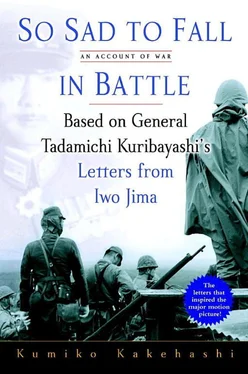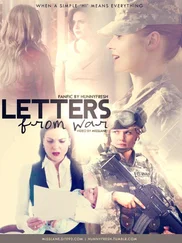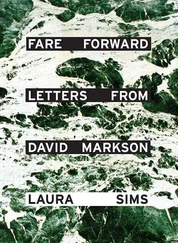And on December 11, 1944:
I really feel sorry for the way your hands get chapped and cracked when winter comes around and the water’s cold. Whenever you’ve been using water, make sure to dry your hands thoroughly then rub them until they get warm.
It’s impossible not to admire the way he repeatedly sends advice and worries about their lives down to such minutiae. What’s special about Kuribayashi is that he doesn’t just say nice things; he always provides detailed advice on how to deal with problems. He seems to have spent a great deal of time thinking about home, trying to imagine the kind of inconveniences his family was having to put up with.
The letters give one the sense that, though far away, he still thought like the head of the household who wants to make life that little bit easier for his family. It’s also possible that the time he spent conjuring up a vivid picture of everyday life in the home where he could no longer be made life at the front that much more livable for him, too.
The American landing could have come at any time when Kuribayashi was writing these letters. The air raids were growing more intense by the day; his attempts to dig underground defenses for an all-out war of resistance were progressing slowly, impeded by the geothermal heat and sulfur vapor released by the digging. And every day, caked in dust and sweat, Kuribayashi was taking hands-on control and inspecting the construction of the installations.
Iwo Jima does not have a single stream; when the Japanese troops dug wells, all they ended up with was saltwater with a high sulfur content. The twenty thousand plus soldiers, including Kuribayashi, had nothing to drink but the rainwater they could collect, and this water, of which there was barely enough to keep them alive, was polluted, and many of the Japanese soldiers fell sick with paratyphoid, diarrhea, and malnutrition.
It was a bleak island where the only reality was war. Maybe the fact that Kuribayashi could turn his thoughts to the kitchen back at home gave him the opportunity to anchor himself to a more normal, more human way of life.
I asked Tarô how his father had seemed before setting off for the front. “There was nothing special or different about him” was his initial answer. His father, he said, was just as relaxed and easygoing as ever.
But later on, as I was asking him about the layout of the house they had lived in back then, he said, as if it had suddenly come back to him: “That business of how my father was behaving before he went off to the front. Now that I think about it, he was busy making some shelves.”
“Shelves?”
“Yes. Shelves for the kitchen and other parts of the house.”
A lieutenant general of that time had a social position equivalent, or maybe even superior, to a member of the cabinet in our times, and this was the night before he was heading off to a battle where he ran every risk of being killed. Nonetheless, the thought of the inconveniences his family would face after he had gone inspired him to pick up a hammer and put up shelves.
In a sense, the Kuribayashi household was not unusual. No doubt fathers all over Japan were doing work around the house for their families as they waited to be dispatched to the front. It was their last opportunity to do any do-it-yourself repairs. But Kuribayashi was different in one important respect.
At the front, it is the judgment of the commanding officer and the orders he gives that decide if the soldiers in his charge live or die. When a soldier is ordered to charge, he has to do so even if he knows that certain death will be the result. Kuribayashi, as commander in chief of both the army and the navy forces, was the one who was going to be giving orders. It was Kuribayashi who would be ordering people to go out and die.
Kuribayashi was also well aware that his task as commander in chief was not to achieve victory.
It was Prime Minister Tôjô Hideki who appointed Kuribayashi to be overall commander in Iwo Jima, and he is reported to have urged him to “do something similar to what was done on Attu.” Attu is a small island in the Aleutian archipelago where, in May 1943, a year before Kuribayashi was sent to Iwo Jima, the Japanese had fought desperately in an effort to prevent the American forces from wresting the island back. They had been slaughtered down to the last man—a fate they called gyokusai , or “honorable death.”
The Imperial General Headquarters ordered Kuribayashi to defend Iwo Jima stubbornly, but his being dispatched to a remote and solitary island in the Pacific was no longer about being victorious or driving back the enemy. Japan no longer had the power to do that. After the country’s defeat at the Battle of Midway, it became clearer by the day that Japan was destined to lose the war as the disparity in military strength grew ever wider. How long could the island hold out? That was the only thing that mattered.
Retreat was not permitted, even if the Japanese were conclusively defeated. “Do something similar to what was done on Attu” meant they had to endure to the bitter end and fight until they had all been killed.
What, then, were they fighting for? If victory was not even a possibility, what overarching goal could justify the deaths of his men as “worthwhile and meaningful”? Kuribayashi, who knew better than anyone the might of the United States and who had been consistently against the idea of attacking them, must have asked himself this same question.
The day after he had bustled about the house making shelves in his role as father and husband, he arrived on the island where a battle he was doomed to lose would be fought—a battle he was doomed to lose, on an island where more than twenty thousand men would go to their deaths on his orders.
CHAPTER TWO
22 KM 2OF WILDERNESS
—
SEEN FROM THE AIR, IWO JIMA LOOKS LIKE AN UGLY SCAB STUCK onto the broad expanse of the ocean. It seems so flat and so thin that you think you could pick it off with your fingernails, and no matter the weather it is always a drab brown in color.
The island has an area of only twenty-two square kilometers—less than half of Tokyo’s Setagaya Ward. It is hard to believe that a combined total of more than eighty thousand Japanese and American troops fought a historic battle over this tiny isolated island. Iwo Jima lies on about the same latitude as Okinawa, but it has no white-sand beaches, no gorgeous tropical flowers in bloom.
The island is somewhat long and narrow, and runs from northeast to southwest. Its shape is often compared to a rice scoop or spatula. Its highest point is the summit of Mount Suribachi on the southwestern tip, which stands 169 meters above sea level, while a plateau 100 meters above sea level extends over the northeast of the island.
This flatness was the primary factor in the destiny of Iwo Jima. The topography was perfect for building runways.
The other Ogasawara Islands were too mountainous for airfield construction. Chichi Jima had a base dating from prewar days and also an airfield, but the uneven topography made it difficult to expand the existing facility or build a new one.
By contrast, Iwo Jima already had two airfields, Chidori and Motoyama, when Kuribayashi arrived to take up his post in June 1944, and a third was under construction in the northeast of the island.
A mere speck of an island it may have been, but it had three airfields. Iwo Jima could serve as an “unsinkable aircraft carrier” out at sea. In the Pacific War, it was the battle in the air that determined the outcome, making Iwo Jima an asset that both the Japanese and the Americans needed and coveted.
The initial plan was to place the headquarters of the 109th Division, now under Kuribayashi’s command, on Chichi Jima because Chichi Jima served as the center of the Ogasawara Islands for command and control, communications, and supplies. Chichi Jima was also much more livable than Iwo Jima, where lack of water and the scorching heat made farming of any kind impossible.
Читать дальше












